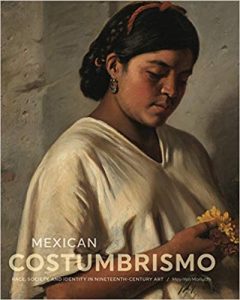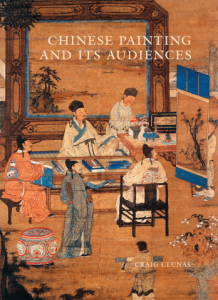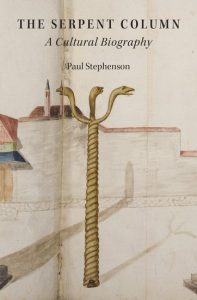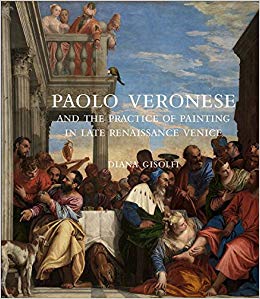CAA News Today
CAA Recognizes Anniversary of Women’s Suffrage at 2020 Annual Conference
posted by CAA — March 19, 2019

Women’s suffragists parade in New York City in 1917, carrying placards with the signatures of more than a million women. (New York Times Photo Archives)
In collaboration with the Committee on Women in the Arts, CAA seeks to offer a selection of sessions, papers, speakers, and related programming for the 2020 Conference in celebration of the Centennial of Women’s Suffrage in the US, while also acknowledging the discriminatory practices that limited voting rights for Indigenous women and women of color, even after the passage of the 19th amendment in 1920.
We hope 50% of the conference’s content will be focused on women-centered research, artistic presentations, and discourse, and addresses the intersectional and transnational complexity of race, ethnicity, class, age, body size, disability, gender and sexual orientation in the arts. Reinforcing inclusivity beyond binary understandings of gender, this initiative seeks to advance a forum for increased dialogue within the context of this historical moment.
The submissions portal for the 2020 CAA Annual Conference is now closed.
CAA at 2019 Advocacy Days in Washington, DC
posted by CAA — March 18, 2019
It’s been a busy month for direct advocacy at CAA! This past month, members of CAA staff attended three national advocacy convenings in Washington, DC: Museums Advocacy Day, Arts Advocacy Day, and Humanities Advocacy Day.
We visited congressional offices to advocate for support for the arts, humanities, and higher education, and continued funding for the NEA, NEH, and IMLS. Our asks also included the reauthorization of the Higher Education Act and support for the Universal Charitable Giving Act and the CREATE Act.
See our on-the-ground updates via Twitter and Instagram.
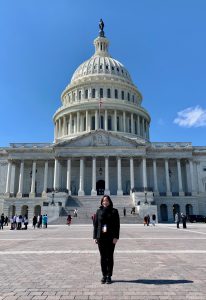
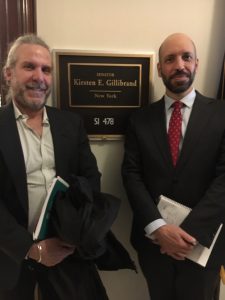
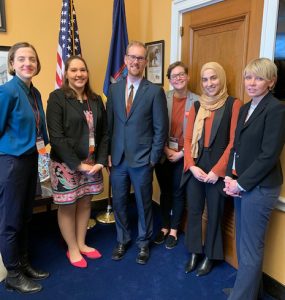
CAA Sponsorship and Partnership Manager Alison Chang; CAA Executive Director Hunter O’Hanian and Legislative Assistant Eric Deeble; CAA Media and Content Manager Joelle Te Paske (far left) and fellow advocates in Rep. Paul Tonko’s office
We visited 15 congressional offices representing four different states, with positive responses from both Democrats and Republicans. We met with staff or dropped off materials with:
Georgia
Rep. Sanford Bishop (D-GA 2nd District)
New York
Rep. Antonio Delgado (D-NY 19th District)
Sen. Kirsten Gillibrand (D-NY)
Rep. Eliot Engel (D-NY 16th District)
Rep. Nita Lowey (D-NY 17th District)
Rep. Sean Maloney (D-NY 18th District)
Rep. Joe Morelle (D-NY 25th District)
Rep. Jerrold Nadler (D-NY 10th District)
Rep. Tom Reed (R-NY 23rd District)
Rep. Kathleen Rice (D-NY 4th District)
Sen. Chuck Schumer (D-NY)
Rep. Paul Tonko (D-NY 20th District)
Rep. Nydia Velazquez (D-NY 7th District)
Oregon
Peter DeFazio (D-OR 4th District)
Texas
Bill Flores (R-TX 17th District)
Learn more about the Advocacy Days below.
View this post on Instagram
MUSEUMS ADVOCACY DAY
February 25-26, 2019
Hosted by American Alliance of Museums
Museum professionals from across the United States gather in Washington, DC, for Museums Advocacy Day. Participants attend sessions outlining key legislative issues affecting the field and meet with their representatives and senators to educate them about the mission of museums and their role in the economy, in adult and child education, and in national culture. Learn more.
ARTS ADVOCACY DAY
March 4-5, 2019
Hosted by Americans for the Arts
Arts advocates from across the country convene in Washington, DC for Americans for the Arts’s annual Arts Advocacy Day each year. Arts Advocacy Day brings together a broad cross section of America’s cultural and civic organizations, along with more than 700 grassroots advocates from across the country, to underscore the importance of developing strong public policies and appropriating increased public funding for the arts. Learn more.
HUMANITIES ADVOCACY DAY
March 11-12, 2018
Hosted by National Humanities Alliance
Humanities Advocacy Day provides the opportunity to connect with a growing number of humanities advocates from around the country. Together, advocates will explore approaches to year-round advocacy on college campuses and in local communities while also preparing for Capitol Hill visits. On March 12, they will visit House and Senate offices to make a persuasive case for federal funding for the humanities. Learn more.
For more on CAA’s advocacy efforts, click here.
We encourage you to be vocal about your support for the arts and humanities. Click here to access the CAA Arts and Humanities Advocacy Toolkit.
Ashley Gardini and Cheyanne Cortez
posted by CAA — March 18, 2019
The weekly CAA Conversations Podcast continues the vibrant discussions initiated at our Annual Conference. Listen in each week as educators explore arts and pedagogy, tackling everything from the day-to-day grind to the big, universal questions of the field.
CAA podcasts are on iTunes. Click here to subscribe.
This week, Ashley Gardini and Cheyanne Cortez discuss the realities of adjuncting.
They are both adjunct instructors at several community colleges in northern California.
Annual Conference Committee Seeks Next Chair
posted by CAA — March 15, 2019
CAA invites nominations and self-nominations for the Annual Conference Chair. This at-large member of the Annual Conference Committee serves a two-year term, beginning February 2020, immediately following the 108th Annual Conference. The Annual Conference Chair Designate shall begin their orientation to the role in May 2019. They will be invited to meetings of the Annual Conference Committee as a non-voting ex officio member at that time.
The Chair oversees the Council of Readers and reports back to the Annual Conference Committee on session topics, including identifying possible areas of content and interest to members that are missing from the submissions received. With CAA staff, the Chair recruits Council of Readers members to read, review, and rank proposals. The Chair shapes the content to the Annual Conference from the submissions as reported back by the Council.
Deadline: April 29, 2019
As a member of the Annual Conference Committee the Chair:
- Works with CAA staff and oversees the execution of the overall goals of the conference
- Ensures that the Annual Conference reflects the goals of the Association
- Makes the Annual Conference an effective place for intellectual, aesthetic, and professional learning and exchange
- Reflects the diverse interests of the membership
- Suggests conference content based on member interest
- Assists in scheduling the variety of chosen sessions, workshops, talks, etc.
- Proposes ways to increase conference participation and attendance
- Proposes new initiatives for the conference
- Proposes candidates for distinguished speakers
The Annual Conference Committee meets three times a year: February – in person at the Annual Conference to examine and discuss the operational aspects of the conference which recently concluded and ideas for the upcoming conference; May/June – on a conference call to review the recommendations by the Council of Readers for the upcoming Annual Conference; October – on a conference call to review final plans and any existing changes for the Annual Conference up to two years out.
Please send a 150-word letter of interest and a CV to Mira Friedlaender, CAA Manager of Annual Conference. Deadline: April 29, 2019.
New in caa.reviews
posted by CAA — March 15, 2019
Ray Hernández-Durán reviews Mexican Costumbrismo: Race, Society, and Identity in Nineteenth-Century Art by Mey-Yen Moriuchi. Read the full review at caa.reviews.
Peter C. Sturman writes about Chinese Painting and Its Audiences by Craig Clunas. Read the full review at caa.reviews.
Fabio Guidetti discusses The Serpent Column: A Cultural Biography by Paul Stephenson. Read the full review at caa.reviews.
Thomas Dalla Costa examines Paolo Veronese and the Practice of Painting in Late Renaissance Venice by Diana Gisolfi. Read the full review at caa.reviews.
Meet Cali Buckley, CAA’s New Grants and Special Programs Manager
posted by CAA — March 14, 2019
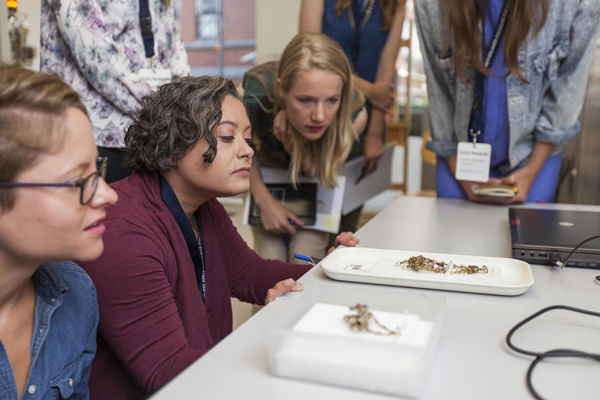
Cali Buckley takes part in the Rijksmuseum’s Museum Objects as Evidence: Approaches to the Material World Summer School, 2018. Photo: Thijs Gerbrandy
We’re delighted to introduce Cali Buckley, CAA’s new Grants and Special Programs Manager and RAAMP Coordinator, who began her full-time role in January after working part-time as the CAA Programs Assistant in 2017. She received her PhD from Penn State University on interactive anatomical models and their creation by craftsmen in the early modern era. Joelle Te Paske, CAA Media and Content Manager, spoke with her in late January to learn more about her research and her hopes for the Resources for Academic Art Museum Professionals (RAAMP) program, which provides publicly accessible resources to academic museum professionals.
Joelle Te Paske: Thanks for taking the time to chat, Cali. So to begin, where are you from?
Cali Buckley: I’m from Pottsville, Pennsylvania. It’s only about three hours from here. It’s north of Philly, best known for Yuengling beer which is the oldest brewery in America. That’s our claim to fame.
JTP: Good to know. And you worked with CAA a few years ago, correct?
CB: Yes, I moved to New York after my Fulbright and worked for CAA for six months as a programs assistant part-time while I was finishing my dissertation. Once I defended and graduated, I moved back to Germany.
I actually have long ties with CAA. Right out of college, I worked for Penn State University Press on art history books. I was able to actually attend CAA and talk to authors, and I worked at the Book and Trade Fair for about three years. It was fun. You can hear people talking about their wonderful book ideas. If I had more time, I would just sit around and see how people pitch these things because it’s fascinating.
I went to Penn State for journalism and then went into publishing right after graduating—I worked on history books and then got really into art history and thought about all the possibilities. Because I guess I had this much narrower idea of traditional art history. And then working on some of these new books really expanded my sense of what that could be.
JTP: That’s great.
CB: I knew some folks in our art history department at Penn State through the editorial board, and I started talking to them about the possibility of my doing my masters there. And I met one of my professors through an editor there. So I planned on going for my masters and then back into publishing, but I completely fell in love with it. I found some great topics, and I just kind of wanted to keep moving forward.
I started going to CAA as a graduate student, so no longer in the Book and Trade Fair. I was part of this group called The Graduate Student Association for Visual Culture. And we would apply for money from Penn State to get groups of us to go to CAA every year. So we would have this group caravan to CAA, all the art historians.
JTP: Sounds ideal.
CB: It’s wonderful. We created this Valentine’s Day tradition because CAA usually falls over Valentine’s Day. And we still get together on the 14th and watch our favorite movie and eat pizza.
JTP: Are you going to do it this year?
CB: Yes, yes, absolutely.
So I started with doing the Book and Trade Fair at CAA. Then I went as a graduate student, gave a talk at CAA in Chicago a few years back. And the same day participated in a roundtable in publishing. CAA’s been huge in my life.
JTP: I’d love to speak a bit about your research, too—early anatomical models and the control of women in medicine.
CB: Originally, when I went into publishing, I was doing weird research projects on interactive books and books as objects. And I used to give talks at Columbia to journalism students in the summer about how to create physical books and how it’s different from books online. How to work with the movement of books and do all these funny things that literary magazines were experimenting with. And then I found this sixteenth-century version of what I was talking about, in the form of an anatomical model.
These have become much more popular in the last ten years but some of these [models] had layers. So they were just images of the body with layers showing the different organs and systems. And that idea of movement and interactivity was fascinating—and a lot of them are inaccurate, even for their time, which makes them even more interesting.
There are all these different layers to audiences, whether you’re trying to highlight the accuracy, which a lot of these are not, or the visuality and the interactivity. And that seems to be more important.
Then I got into ivory models, which is a huge project of mine, creating a whole catalogue of them. That’s a big part of my dissertation.
JTP: Interesting.
CB: I found 180 in the world and I have new people emailing me every year. They’re a much bigger phenomenon than we thought and I’ve done quite a bit of research in Germany to pull these threads together and find out more about their history. I’ve been trying to bring these to light and hopefully I’ll have an article out soon.
JTP: That’s terrific. I’m curious—what is one of your favorite CAA conference memories?
CB: I think one of the great memories was actually an event connected to CAA where I was giving a talk with someone from The Art Institute of Chicago and they let us do a private showing of prints and different objects [at the museum]. Some of the prints were the actual interactive prints that I had worked on.
JTP: That’s always exciting, to be in the same room with objects you’ve studied.
Do you have a favorite exhibition you’ve seen recently?
CB: I just went to the Brueghel exhibition in Vienna and it was amazing. I mean, it was really well done and it went through both his history and paintings and a lot of his earlier drawings and sketches. But it also included a lot of the process to make the materials—some of the wooden planks and those sorts of thing that he used, and the process of painting and printing. That process stuff was really interesting. I think that should be in a lot more exhibitions.
JTP: I agree. My first job was as a registrar at a gallery and I can never quite divorce myself from “How much did the crate cost?”! Because you have a different sense of the process.
CB: Absolutely. I work a lot on materiality. I’m interested in the process of how a work was made, what it’s made of, and how the material affects it. I actually started taking a lot more art classes in different areas to get a feel for it.
I took a class in wax modeling with someone who does wax moulages and restoration. Moulages are generally medical things. So I essentially made a moulage using wax of some skin condition! That was a fun workshop. I was at the Narrenturm which is an old insane asylum in Vienna that now houses a pathological museum. And then you spend a couple of hours making these wax moulages. It was just such a bizarre and wonderful day.
JTP: That does sound bizarre and wonderful.
So, thinking forward to your work with RAAMP, what do you find the most exciting part of that resource?
CB: I’m excited to be [at CAA] and working on a diversity of projects so that I get that bigger, that broader umbrella of what’s new and exciting outside of my little area of the research world. Part of that is the RAAMP program, which really allows people in various facets of the academic and museum worlds to share experiences and have discussions about issues facing those institutions—and those who they serve—today. I love the idea of having meetings and sharing discussions online, because that way they are more accessible. Our Coffee Gatherings are like afternoon meetings at a café with a small audience that can discuss matters in a casual way, but they are also recorded now so students can always watch these later to gain insight into particular matters. The video practica are similar, but more streamlined with one person discussing a specific topic. I can’t wait to get more Coffee Gatherings together because those small group discussions can be really valuable.
JTP: How do you see of the role of academic art museums moving forward?
CB: Academic art museums are as integral as ever to education, but they are facing different issues as time goes on while also dealing with age-old dilemmas. They need to learn how to use the latest technology and how to deal with the latest controversies over artwork, but they also need to engage students. The whole idea of RAAMP is to provide resources for academic art museums to tackle these problems. Part of that is providing a network of professionals who share their expertise.
I do think that museums have to be aware of the social environment and how to contend with criticism. Our session at the 2019 conference allows us to open up this topic to see how artists and professionals deal with some very serious issues of artwork being interpreted as offensive. Artwork is inherently open to interpretation, so I think it’s important to discuss how museums act as mediators to a degree—and how their role is balanced with their place in an academic institution.
I should add that one of my favorite teaching experiences was being able to introduce first-year students to the Palmer Museum of Art at Penn State and asking them to describe the giant [Helen] Frankenthaler painting we had hanging there. There’s nothing quite like it when a student realizes that they have history right in front of them.
Announcing CAA Publication Fund Award Winners
posted by CAA — March 13, 2019
2019 TERRA FOUNDATION FOR AMERICAN ART INTERNATIONAL PUBLICATION GRANT WINNERS
CAA is pleased to announce the 2019 recipients of the Terra Foundation for American Art International Publication Grant. This program, which provides financial support for the publication of book-length scholarly manuscripts in the history of American art, is made possible by a generous grant from the Terra Foundation for American Art. For this grant, “American art” is defined as art (circa 1500–1980) of what is now the geographic United States.
 The ten Terra Foundation grantees for 2019 are:
The ten Terra Foundation grantees for 2019 are:
- Anni Albers, On Weaving, translation in French, Les Presses du Réel
- Anna Arabindan-Kesson, Black Bodies, White Gold: Art, Cotton and Commerce in the Atlantic World, Duke University Press
- François Brunet, La naissance de l’idée de photographie [The Birth of the Idea of Photography], translation from French into English, Ryerson Image Center
- Julia Bryan-Wilson, Art Workers: Radical Practice in the Vietnam War Era, translation in Korean, Youlhwadang Press
- Eddie Chambers, ed., The Routledge Companion to African American Art History, Taylor & Francis
- Julia Drost, ed., Networks, Museums and Collections. Surrealism in the U.S., translation from French to English, Deutsches Forum für Kunstgeschichte Paris
- Natilee Harren, Fluxus Forms: Scores, Multiples and the Eternal Network, University of Chicago Press
- Elaine de Larminat, Houses and Homes. Photographier la maison américaine, Le Point du Jour
- Jody Patterson, Modernism for the Masses: Painters, Politics, and Public Murals in New Deal New York, Yale University Press
- Laurence Schmidlin, La spatialisation du dessin dans l’art américain des années 1960 et 1970, Les Presses du Réel
The International Author Conference Subventions confer two non-US authors of top-ranked books travel funds and complimentary registration to attend CAA’s 2020 Annual Conference in Chicago, February 12-15; they also received one-year CAA memberships.
The two author awardees for 2019 are:
- Elaine de Larminat
- Laurence Schmidlin
See a list of recent recipients
2018 WYETH AWARD WINNERS
Since 2005, the Wyeth Foundation for American Art has supported the publication of books on American art through the Wyeth Foundation for American Art Publication Grant, administered by CAA. For the grant, “American art” is defined as art created in the United States, Canada, and Mexico.
The 2018 grantees are:
- Bellion, Wendy, The Great Fall: Iconoclasm in New York City since the American Revolution (Penn State University Press)
- Boone, M. Elizabeth, “The Spanish Element in Our Nationality”: Spain and America at the World’s Fairs and Centennial Celebrations, 1876-1915 (Penn State University Press)
- Coffey, Mary, Orozco’s American Epic: Myth, History, and the Melancholy of Race (Duke University Press)
- Deloria, Philip, Becoming Mary Sully: Toward an American Indian Abstract (University of Washington Press)
- Diack, Heather, Marks of Contingency: The Photographic Conditions of Conceptual Art (University of Minnesota Press)
- Jentleson, Katherine, Gatecrashers: The Rise of the Self-Taught Artist in America (University of California Press)
- Monahan, Anne, Horace Pippin, American Modern (Yale University Press)
- Senf, Rebecca A., Making a Photographer: The Early Work of Ansel Adams (Yale University Press)
- Strathman, Nicole D., Through a Native Lens: American Indian Photography (University of Oklahoma Press)
- Taylor, Sue, Grant Wood’s Secrets (University of Delaware Press)
See a list of recent recipients
FALL 2018 MEISS FUND RECIPIENTS 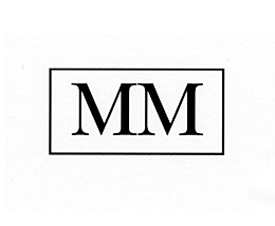
Twice a year, CAA awards grants through the Millard Meiss Publication Fund to support book-length scholarly manuscripts in the history of art, visual studies, and related subjects that have been accepted by a publisher on their merits, but cannot be published in the most desirable form without a subsidy. Thanks to the generous bequest of the late Prof. Millard Meiss, CAA began awarding these publishing grants in 1975.
The Millard Meiss Publication Fund grantees for Fall 2018 are:
- Amstutz, Nina, Caspar David Friedrich: Landscape, Science, and the Self, (Yale University Press)
- Campbell, Aurelia, Architecture and Empire in the Reign of Yongle, 1402-1424, (University of Washington Press)
- Chanchani, Nachiket, Mountain Temples and Temple Mountains: Architecture, Religion, and Nature in the Central Himalayas, (University of Washington Press)
- Deloria, Philip, Becoming Mary Sully: Toward an American Indian Abstract, (University of Washington Press)
- Gerschultz, Jessica, Decorative Arts of the Tunisian École: Fabrications of Modernism, Gender, and Power, (Penn State University Press)
- Mahon, Alyce, The Sadean Imagination: The Marquis de Sade, Terror, and the Avant-Garde (Princeton University Press)
- McDowell, Tara, The Householders: Robert Duncan and Jess, (MIT Press)
- Tsultemin, Uranchimeg, A Monastery on the Move: Art and Politics in Later Buddhist Mongolia, (University of Hawai‘i Press)
See a list of recipients from 1975 to the present
CONTACT
Questions? Please contact Cali Buckley, CAA grants and special programs manager, at 212-392-4435.
News from the Art and Academic Worlds
posted by CAA — March 13, 2019
Want articles like these in your inbox? Sign up: collegeart.org/newsletter
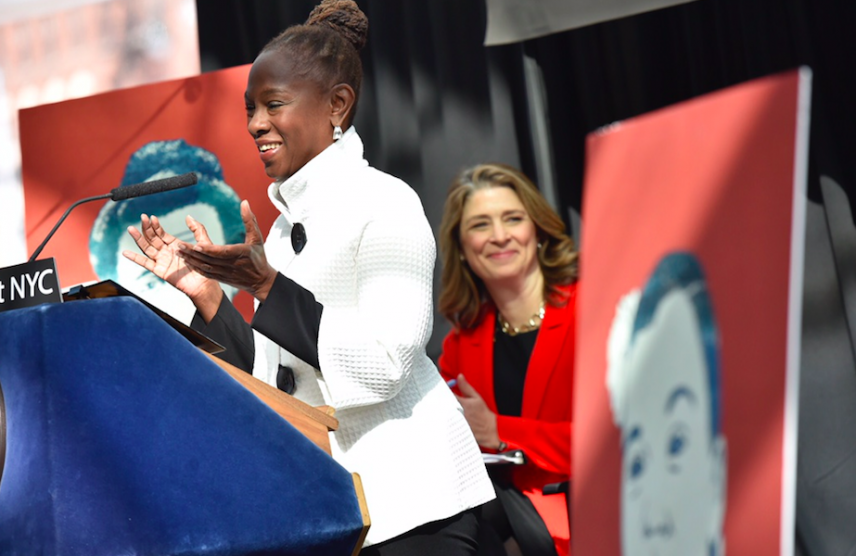
New York City First Lady Chirlane McCray announced the new She Built NYC monuments this week in Brooklyn. Photo: Ed Reed
She Built NYC Announces Statues Honoring Four More Trailblazing Women
In addition to a previously announced monument for Rep. Shirley Chisholm, New York City will honor these four trailblazers. (She Built NYC)
Trump Sets Workforce Training, Student Loan Overhaul as Budget Priorities
Trump’s fiscal year 2020 budget proposal was released this week. Here are the implications for higher ed. (Education Dive)
Finding the Right Training and Career Development Opportunities for Your Organization
Where to begin? Start by identifying the goals you want to achieve. (Scholarly Kitchen)
Governor Dunleavy’s Budget Plan Would ‘Gut’ University of Alaska System
CAA has signed a letter along with 27 other professional societies urging reconsideration of this plan. The university stands to lose 40% of its total budget. (Anchorage Daily News)
The Power of a Paid Internship: Creating Pathways to Careers in Museums
A helpful case study from The Phillips Collection. (AAM)
Why Is Work by Female Artists Still Valued Less Than Work by Male Artists?
A look at the numbers with sociologist Taylor Whitten Brown. (Artsy)
Apply to Join the CAA Council of Readers
posted by CAA — March 12, 2019
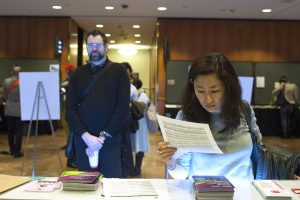
Attendees at the 2019 Annual Conference in New York. Photo: Ben Fractenberg
Beginning this year, we are pleased to announce a new opportunity to help shape Annual Conference session content. In preparation for the 2020 Annual Conference in Chicago, the Annual Conference Committee will appoint a Council of Readers to read proposals submitted by CAA members and serve a crucial role in the review process.
The Council will be tasked with reading proposals with a focus on their specialty and will provide the knowledge and expertise of their fields to help shape the conference.
Pleas email Mira Friedlaender, Manager of Annual Conference, mfriedlaender@collegeart.org, or Tiffany Dugan, Director of Programs and Publications, tdugan@collegeart.org, with any questions.
CWA Picks for March 2019
posted by CAA — March 11, 2019
CAA’s Committee on Women in the Arts selects the best in feminist art and scholarship to share with CAA members on a monthly basis. See the picks for March below.
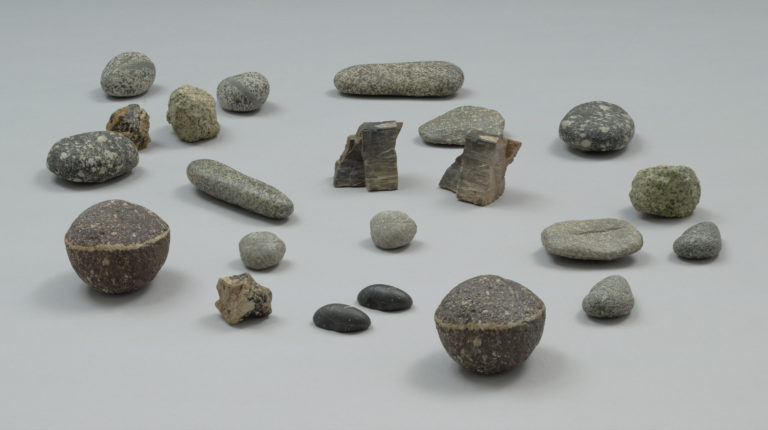
Vija Celmins, To Fix the Image in Memory I-XI, 1977-82; The Museum of Modern Art, New York, gift of Edward R. Broida in honor of David and Renee McKee; © Vija Celmins; photo: courtesy Matthew Marks Gallery. On view at SFMoMA through March 31st.
Judith Godwin: An Act of Freedom
February 14 – March 16, 2019
Berry Campbell Gallery, New York
Judith Godwin: An Act of Freedom contributes to the important revisionist history on the women of Abstract Expressionism with the presentation of twenty-three gestural canvases produced from 1954 through 2007. A native of Suffolk, Virginia, Godwin (b. 1930) attended Mary Baldwin College in Staunton (1948-50) and completed her undergraduate degree in 1952 at Richmond Professional Institute of the College of William and Mary (now Virginia Commonwealth University). She moved to New York in 1953, where she was invited to attend frequent dance classes and performances by Martha Graham, with whom she established a lifelong friendship. She also studied briefly with Will Barnet and Vaclav Vytlacil at the Art Students League, followed by classes with Hans Hofmann in Provincetown, MA, and in the fall 1954 at 52 West Eighth Street. Inspired by Hofmann’s color principles, Godwin’s emerging abstractions in the mid-1950s, many on view here, display a tightly structured organization of planar elements that develop into expansive and sweeping arcs, angles, and spatial breaks across the painterly surface. An interesting comparison is Japanese painter Kenzo Okada (1902-82), another formative association for Godwin encouraging her investigations in Zen Buddhism. Godwin’s paintings were included in the important traveling exhibition, Women of Abstract Expressionism that originated at the Denver Art Museum in 2016.
VIJA CELMINS: TO FIX THE IMAGE IN MEMORY
December 15, 2018 – March 31, 2019
San Francisco Museum of Modern Art
The first retrospective of Vija Clemins in North American in more than 25 years, this exhibition presents over 140 small scale, exquisitely detailed paintings, drawings, and sculptures of the physical world by the American-Latvian artist. Living and working in New York since 1981, Celmins’ early work was inspired by Pop Art, painting realistic depictions of everyday objects, followed by drawings and paintings of newspaper photographs. Her Untitled (Big Sea) series in the 1970s, depicting the ocean texture completely filling the picture plane, unbroken by any horizon or secondary life or object, brought her acclaim as she developed her meticulously thorough technique. Her intention more about the process than the photographic reflection or landscape aesthetic, the works’ texture and character present a fascinating distraction, opposing romantic cliché.
ROSE ENGLISH. FORM, FEMINISMS, FEMININITIES
March 1 – April 13, 2019
Richard Saltoun Gallery, London
Since March 2019 Richard Saltoun Gallery in London is dedicating its annual programme to women, as part of their mission to support female artists who are under-recognized and under-represented. This inaugural exhibition celebrating the Gallery’s commitment to protest gender inequality in the art world, showcases Rose English’s works from the earlier stages of her career. The exhibition includes a range of artworks from 1970s and early 1980s demonstrating the richness of English’s unique artistic vocabulary, her curiosity and willingness to experiment with processes and materials, and her versatility as an artist eager to engage with photography, ceramics, collage, film, installation and performance. Her interest in politics, social issues, aesthetics, philosophy and popular culture can be traced in her early works. What is particularly interesting, is the artist’s subversive understanding of feminism and femininity which she explores through challenging and interweaving diverse forms, their conventions and histories. Plato’s Chair (1983) exhibited in the final room of the gallery is one of her most important early monologue performances staged at the Western Front in Vancouver, Canada in 1983.
Erika Verzutti: Mutations / Creations 3
February 20 – April 15, 2019
Centre Pompidou, Paris
Mutations is the first monographic exhibition in Europe of Erika Verzutti, the Brazilian artist (b. 1971, São Paulo) known for her vital exploration of the materialization and facture of sculptural forms in bronze, ceramic, cement and papier-mâché. Occupying the entirety of Gallery 3, Verzutti’s provocative sculptures and reliefs, often animalistic, vegetal, and botanical abstractions, are here conceived as “families” or generative groupings and “conversations,” such as Tarsila, an homage to the brilliant painter and “mother” of Brazilian modernism, Tarsila do Amaral, or The Brasilia Family, a title conjuring the extraordinary industrialization of the new capital city in postwar Brazil. A central object embodying a massive swan’s shapely form evokes matrilineal sources and tribal connectivity. In relationship to the rational, geometric panels of Brazilian Concretism in the 1950s or the gestalt ideals of Neo-Concretist “non-objects,” Verzutti’s playful, sardonic and feminist gestures invite new and welcome readings on texture, materiality, and opticality.
DINOSAUR IN THE DOLLHOUSE
January 31 – April 19, 2019
Carlow University Art Gallery, Pittsburgh
This process and collaborative oriented exhibit includes paintings by artists Sarah Jacobs, Kristen Letts Kovak, and Katherine Tzu-Lan Mann around legacy, possibility and evolving context. One individually completed painting by each artist is complemented by another that was influenced by the paintings by the other two artists. Moreover, the trio will create a collaborative painting in the gallery during the exhibition’s run that will be finished by the end. Katherine Tzu-Mann’s expansive, expressive colorful paintings explore how painting can “capture flux, abundance, waste, fertility, and the collision and collusion of diverse forms” from material, to process to their animated result of shapes, moving lines and colors. Also rich in movement and hue, Kristen Letts Kovak’s paintings seem to take more botanical form, if imagined, as the artist explains her more intuitive approach, her paintings are “both records of my perceptions, and independent objects for observation.” Sarah Jacobs’ process is pattern-driven, meticulously hand-painted, bright and complex work that relates to human vulnerability. The artists share a mentor, who provided impetus for the title reflecting artists’ perhaps seemingly random yet purposely juxtaposed choices.
She Persists: A Century of Women Artists in New York, 1919-2019
January 22 – December 19, 2019
Gracie Mansion, New York
What does it mean to make a difference while residing in “The People’s House?” First Lady of New York City Chirlane McCray embodies strident activism in her support of this important exhibition at Grace Mansion, the official residence of the Mayor and his family. This smart installation of 44 modern and contemporary women artists marks a century of persistence since suffrage and shows 60 artworks by women who represent diverse origins and cultural positions intersecting life and culture in New York City. Curator Jessica Bell Brown brings together photographs, objects, archival materials, and artworks documenting diverse forms of political resistance and power struggles (LGBTQ and AIDS awareness, for example) and art historical and proto-feminist interventions in the twentieth-century canon (Abstract Expressionist modern women, for instance), all of which thematically explore ideas contending with “complicated histories, the body as battleground, picturing people, and expanding abstraction.” She Persists presents an extraordinary range of artists: early modernists and social realists Florine Stettheimer, Isabel Bishop, and Theresa Bernstein; photographers Berenice Abbott, Ruth Orkin, Perla de Leon and Consuelo Kanaga; video and performance artists Mierle Laderman Ukeles, Martha Rosler and Ana Mendieta; and postwar abstractionists Betty Parsons, Helen Frankenthaler, Grace Hartigan, Lee Krasner, and Carmen Herrera. Kara Walker, Simone Leigh, Elizabeth Catlett, Augusta Savage, and Faith Ringgold represent broad proposals on African-American narratives. Shirley Chisholm, the Brooklyn-born Congresswoman, summarizes the rallying cries for women’s rights in her 1974 speech: “Forget traditions! Forget conventionalisms! Forget what the world will say whether you’re in your place or out of your place Stand up and be counted.”



